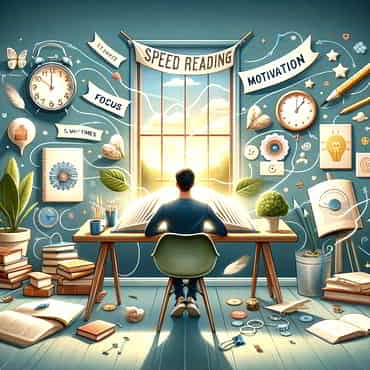Speed Reading Techniques: Processing Information Efficiently

Estimated reading time: 9 Min
If you feel overwhelmed by the flood of information you’re expected to absorb every day, learn and practice speed reading techniques to change your life!
Each day, we expect you to absorb a flood of information.
If this overwhelms you, learn and practice speed reading.
It can change your life!
We read emails, reports, books, and online articles.
It’s undeniable that reading is a key part of our lives.
Now, I’m going to introduce you to speed reading, a skill that can help you navigate this deluge with ease.
This isn’t about gulping down text at breakneck speed; it’s also about processing information.
Efficient reading saves time.
It also boosts your ability to understand and remember what you read.
You might be a student facing many textbooks or a professional keeping up with industry trends.
Or, someone reading for pleasure.
Speed reading can change how you absorb information.
You’re going to learn about the mechanics of speed reading.
You’ll also learn how these methods could streamline your reading. They could transform it from a tedious task into an efficient and enjoyable activity.
And, there are more benefits to speed reading than personal productivity. It also helps your brain. For example, it improves memory and focus.
Next, I’ll take you through the brain-text connection.
I’ll explain how we process written information.
Understanding this process helps.
It’s where efficient speed reading starts.
It’s the foundation.
We’ll build techniques and strategies on it.
They will help you read not only faster, but smarter too.
The Brain-Text Connection: How We Process Written Information
Have you ever wondered what’s happening in your head when you’re scanning these words?
I’m going to explain how our brains handle the tiring task of reading.
It’s a hard mental process that involves decoding symbols to find meaning.
It’s an impressive feat when you think about it!
This isn’t about seeing letters on a page.
It’s about how your brain understands words and makes ideas from them in a flash.
That instant is key.
It’s when you go from seeing to understanding.
It’s vital in speed reading.
Here’s the kicker; your brain is capable of processing words much faster than most of us actually read.
Now, let’s crack the code on common barriers to fast reading.
For many, it’s easy to get bogged down by sub-vocalisation—that’s the inner voice you hear in your head as you read.
While it’s a natural part of reading, it can also be a speed bump on the road to efficiency.
But don’t worry too much about it; we’ll tackle this in greater detail later on.
Here’s what you need to remember.
You start by understand your brain’s current relationship with reading.
Once you’re in tune with how your mind processes text, you’re ready to reshape and speed up your reading habits.
Surveying Speed Reading Techniques: Methods and Myths
I’m going to share with you a closer look at the techniques acclaimed for increasing your reading speed.
Speed reading is about seeing words faster. It is also about understanding and remembering that information.
Some methods are not created equal, and we need to debunk the myths surrounding them.
You’re going to find out about popular methods. One is the “Pointer Method.” In it, a finger or pen helps guide your eyes at a steady pace across the page.
There’s also the Previewing Method. You first skim the material to get a basic understanding before diving in.
Also, don’t ignore RSVP. It flashes words one at a time on a device at a set speed.
Now, what about the myths?
The idea that speed readers don’t comprehend what they’re reading is a common misconception.
When trained, speed readers can have equal comprehension. They may even have better comprehension than traditional readers.
Another myth I hear a lot about is that you can quadruple your reading speed overnight.
If you want real results, don’t worry about overnight miracles.
It’s a skill that develops over time with consistent practice.
Choose something that rings true with you when selecting a speed reading technique.
There’s much opportunity in personalizing your approach.
Also, your first attempt doesn’t need to be your last.
You can always adjust your approach down the road.
Eye Movement Mastery: Pacing for Peak Performance
You’re going to find out about the subtle yet vital role of eye movement in speed reading.
It’s often overlooked, but how your eyes skate across a page has a huge impact on your reading pace.
Traditional reading involves a lot of stop-and-go eye movements called fixations.

Each time your eyes halt on a word or group of words, it’s a fixation.
Too many of these, and your reading slows to a crawl.
Here’s where pacing tools, like a pen or finger, can guide your eyes more across the text, cutting down on jerky stops.
Don’t worry too much about occasional regressions, like when your eyes backtrack to reread text.
It happens, but as you practice, it’ll become less frequent.
Speed reading trains your eyes to move at a steady pace.
This minimises regressions and boosts your speed.
Make a game out of practicing these techniques.
Set aside a book.
Then, practice moving your eyes faster than is comfortable.
It feels odd at first, but like any skill, you improve with practice.
You’ll notice that better eye pacing speeds up reading. It increases your speed.
Imagine sailing through paragraphs with increased comprehension.
As your eye movement improves, you must fill your mind with the right words.
This is where we transition into expanding your vocabulary.
Expanding Vocabulary: Building a Foundation for Quicker Comprehension
I’m going to let you in on a little secret: a vast vocabulary is a speed reader’s best friend.
That’s right, to grasp the meaning of a text, you need to understand the words without skipping a beat.
You must recognise words.
You must grasp their meaning.
You can always adjust your approach later.
But, starting with a strong vocabulary base is key.
Why?
Because each time you come across a word you don’t know, you slam on your mental brakes.
That pause, even if it’s a second, can disrupt your reading flow and reduce your comprehension.
Choose an exercise that you like. It could be a daily word app, reading, or playing word games.
Anything that exposes you to new terms and their usage can help build that foundation.
Remember, consistency is vital.
You’ll learn new words less often if you only sometimes read new things.
Want to boost your reading efficiency?
Then, use new words in talk or writing.
This can reinforce your memory.
It’s one thing to recognise words; it’s another to use them.
And guess what?
Using them helps fix their meanings in your mind.
This enables faster recall and understanding.
Setting aside time for vocabulary is as valuable as practicing speed reading.
You don’t need to be a walking thesaurus.
But, knowing many words lets you read faster and better.
Now, let’s move to the next part of our exploration.
Let’s see how you can use technology to improve your reading.
Technology is changing how we read.
It’s also revolutionising how we improve skills, like speed reading.
Technology Aids: Using Apps and Tools to Level Up Your Reading
Technology is no stranger to speed reading.
In fact, it’s a powerful ally.
Here, you’ll find out about many apps and tools.
These tools are to help you process information faster.
They can help you process information faster.
Imagine having a set of digital tools.
They can guide your eyes through text quickly.
They can also highlight key phrases and words to improve understanding.
That’s exactly what these apps and tools do.
You can choose from rapid serial visual presentation (RSVP).
Or, you can use apps to track your reading speed.
The choices are plentiful.
I’m here to help you narrow down some recommended apps that stand out in the crowd.
For instance, apps like Reedy, Spreeder, and Speed Reading Trainer offer settings that you can customise.
These settings control text speed and track your progress over time.
But, they’re not about swiping through paragraphs at lightning speed.
It’s also about using these tools as a supplementary aid to traditional reading.
They should improve your reading strategy.
But, they should not replace the basics of good comprehension.
Incorporating these technical aids into your everyday reading can be seamless.
Start with a few minutes a day with an app, increasing your use as your confidence grows.
Over time, you might start to notice a natural improvement in your reading pace.
This happens even when reading print.
Technology adds a new dimension to speed reading.
It can adapt to your pace and preferences.
Choose something that attracts you.
It should keep you motivated as you develop your speed reading skill.
The Mindset for Success: Beyond the Page
There’s more than just the mechanics of speed reading; mindset is important too.
Maintaining focus and motivation can be as vital as the techniques themselves.
Here’s why: without the right mindset, even the best methods won’t stick.

Now, about focus—it’s the key to locking down whatever you’re reading.
But here’s the thing; concentration doesn’t thrive amidst chaos.
Do your best to create an environment that’s free from distractions, where your mind can hone in on the task at hand.
This might mean tidying your reading space or finding the time of day when you concentrate best.
Now, let’s talk motivation.
You need to keep asking yourself, Why am I doing this?
Cling to that reason like it’s the last cookie in the jar.
On those days, words crawl instead of race.
It’s that “why” that will keep you moving.
A reading routine can add speed to your life.
It does it as if you are learning to brush your teeth.
Choose something that you enjoy reading—something that resonates with you.
Set aside specific times for practice, and make it a habit.
It might be every morning with your coffee or during your lunch break.
Find that slot in your day that works for you.
Remember, this isn’t just about efficiency: it’s also about effectiveness.
As you start to track your progress, keep in mind why you’re pursuing this skill.
Also, note how much you’ve already achieved.
Keep pushing, stay curious, and that ceiling you think is there might turn out to be the floor.
Summary: Continual Improvement Requires Measuring Progress and Overcoming Plateaus
I’m going to be blunt: becoming a speed reader isn’t a one-and-done deal.
It requires perseverance and regular practice.
You’ll see improvements at first.
But, you may hit plateaus where progress stalls.
Don’t let that discourage you. It’s all part of the journey towards processing more information.
I recommend keeping a reading log.
It allows you to track the books you’ve read, the time you’ve spent, and your comprehension.
This isn’t about measuring your progress.
It’s about seeing patterns and areas to improve.
If you hit a plateau, change up your practice a bit.
Try new types of texts or push yourself with more challenging material.
Remember to celebrate your victories, no matter how small.
Every extra word per minute is a step in the right direction.
Choose something that you enjoy as a reward.
It’s as simple as taking a moment to appreciate the free time you’ve earned.
In my view, the main goal of speed reading is to read faster.
But, it’s also to enrich your life with the knowledge and time it frees up.
So, if you want to keep on making progress, challenge yourself.
Use varied reading materials and read for different purposes.
You can always tweak your techniques and strategies as you go.
What matters is that you’re moving forward.
You’re gaining knowledge and enjoying the journey.
And guess what?
Once you’ve made speed reading a habit, it will feel less like a skill you’re working on.
It will feel more like your new, supercharged way of learning.
So give speed reading a chance and let us know what works for you in the comments.
Remember to share!
🙂
Richard






